Black Stork [Ciconia nigra] Haven: Wings, Nature, and Conservation
Scientific Classification
| Kingdom | Phylum | Class | Order | Family | Genus | Species |
|---|---|---|---|---|---|---|
| Animalia | Chordata | Aves | Ciconiiformes | Ciconiidae | Ciconia | Ciconia nigra |
Black Stork
The black stork, or Ciconia nigra, is one of the bigger species of birds in the Ciconiidae family. This bird, which was first mentioned by Carl Linnaeus in the 10th edition of Systema Naturae, is typically 95–100 cm (37–39 inches) long with an amazing wingspan of 145–155 cm (57–61 inches).
Summary
- Appearance:
- Black feathers with a stark contrast to white underparts.
- Narrow, pointed beak and long crimson legs of the same red shade are distinguishing features.
- Distribution:
- Widely distributed but not abundant.
- Breeding sites in Portugal, Spain, central and eastern Europe.
- Habitat extends eastward over the Palearctic to the shores of the Pacific Ocean.
- Migration:
- Long-distance migrant wintering in Sub-Saharan Africa and the Indian subcontinent.
- Avoids direct Mediterranean Sea crossing during migration, preferring detours via the Levant, Strait of Sicily, or Strait of Gibraltar.
- Behavior and Habitat:
- Population in Southern Africa does not migrate.
- Shyer and more reserved compared to the white stork.
- Often observed alone or in pairs, preferring marshy areas and rivers.
- Stalks prey in shallow water, feeding on insects, small fish, and amphibians.
- Breeding:
- Nests on large deciduous or coniferous trees, boulders, or under overhangs in mountainous locations.
- Incubation of two to five greyish-white eggs by both sexes for 32 to 38 days.
- Birds need 60 to 71 days to fly away after hatching.
- Conservation Status:
- Classified as “least concern” by the International Union for Conservation of Nature.
- Status uncertain, with increasing numbers in the Iberian Peninsula and decreasing in China and India.
- Conservation efforts include the African Black Stork Action Plan by Wetlands International.
- Legal protection provided through the African-Eurasian Waterbird Agreement and the Convention on International Trade in Endangered Species of Wild Fauna and Flora.
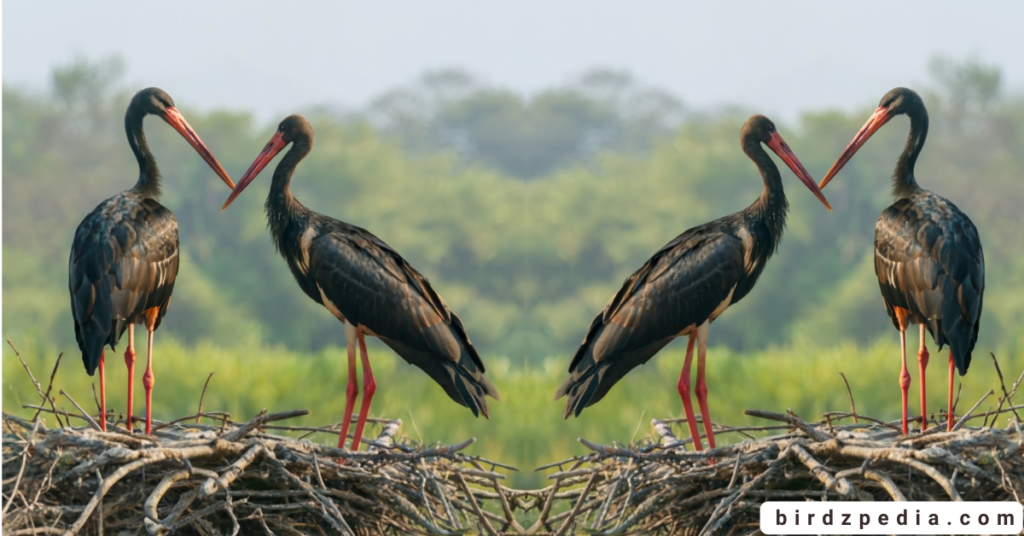
Species in same Genus
| Scientific Name | Common Name |
|---|---|
| Ciconia ciconia | White Stork |
| Ciconia episcopus | Asian Woollyneck |
| Ciconia nigra | Black Stork |
| Ciconia stormi | Storm’s Stork |
Description
A massive bird of prey, It has dimensions of 145–155 cm (57–61 in) in length, 95–100 cm (37–39 in) in width, and around 3 kg (6.6 lb) in weight. Long legs, a long, straight red beak, and a long neck are some of its distinguishing characteristics. It is quite tall, reaching a maximum height of 102 cm (40 in).
They may be clearly distinguished from the Abdim’s stork (C. abdimii) by its predominantly green bill, legs, and feet, as well as its white lower back and rump. The plumage of the juvenile Ciconia nigra is similar to that of the adult, but in some areas it is less glossy and browner than the mature black feathers of the adult.
It is distinguished by pale-tipped scapulars, wings, and upper tail coverts, as well as by possessing greyish-green legs, a bill, and bare skin around the eyes. It may be mistaken for the juvenile yellow-billed stork despite sharing certain traits including whiter mantle and wings, a longer bill, and white under the wings.
Key Facts
- Summer Range:
- Extends from Central Europe to Eastern Asia (Siberia and northern China).
- Includes countries like the Czech Republic, Estonia, Poland, Lower Saxony, Bavaria, Hungary, Italy, and Greece.
- Migration Routes:
- Two main migration routes from Europe to Africa: Iberian Peninsula, Turkey, and the Levant.
- Western German black storks use these routes to reach Africa.
- Wintering Locations:
- Populations winter in diverse locations: tropical Africa, Asia, Falémé River basin (Senegal, Guinea, Mauritania), Sinai route (Ethiopia, Central African Republic, Chad, Nigeria).
- Other Populations:
- Small population in Southern Africa, including Mozambique, eastern South Africa.
- Occasional sightings in Zimbabwe, Eswatini, Botswana, Namibia.
- Asian Migration:
- Summer in eastern Russia and China.
- Winter in southern China; occasional sightings in Myanmar, northern Thailand, Hong Kong, and Myanmar.
- Habitat and Breeding:
- Attracted to wooded regions, breeds in large swampy marshes with interspersed woods.
- Found in rivers, lakes, ponds, estuaries, freshwater wetlands.
- Breeds in Xinjiang, northwest China, northern Mongolia, northeastern China; occasionally seen in Afghanistan and the Korean Peninsula.
- Human Interaction:
- Avoids close contact with humans, even in the Caspian lowlands.
- Conservation and Population:
- Declared extinct in Belgium but started breeding again in the Ardennes region by 2000.
- 2006 population in Spain and Portugal estimated between 405 and 483 pairs.
- Population decline in Iran due to wetland drainage.
- Distribution:
- More prevalent in eastern Transcaucasia than in the western areas.
- Breeding records in various regions of Iran (Razavi Khorasan, Fars, Kerman, Khuzestan, East Azarbaijan).
- Eastward Movement:
- Occasionally seen in mountainous and wooded regions up to 60°–63° N, spanning Siberia to the Pacific Ocean.
- Breeding south of Siberia in Xinjiang, northwest China, northern Mongolia, and northeastern China.
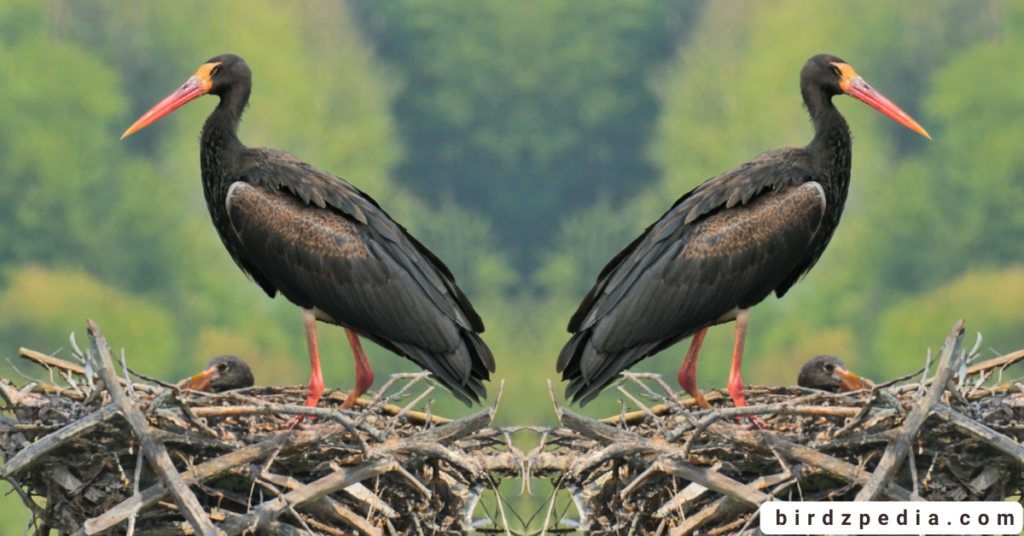
Migration
Early August through October sees migration, with a notable outflow in September. They are free to move in their non-breeding habitats even though some populations in southern Africa and Iberia are essentially non-migratory.
Although not as much as the white stork, that bird is a soarer that depends on warm air thermals for prolonged flights. Because thermals can only form over land, the black stork and other huge raptors have to fly across the Mediterranean at its narrowest spots.
Thus, many of them travel south along key routes including the Bosphorus, Sinai, and Gibraltar. The journey is approximately 5,667 km (3,521 mi) long if taken the western route and 7,000 miles (4,300 km) long if used the eastern route, according to satellite monitoring.
The average time for the eastern route is 80 days, whereas the average time for the western route is 37 days. The western path round Gibraltar Bay and Gibraltar Rock, before veering southwest toward the strait’s center and Morocco.
Many birds are in the air near the coast of the Sahara. Ten percent of western storks decide to fly over the Strait of Sicily, which divides Sicily, Italy, from Cap Bon, Tunisia. They stop over at a number of notable locations in Spain along their migration route,
including Doñana National Park, the National Hunting Reserve in Cíjara, the Natural Park of the Sierra Hornachuelos, and Montfragüe National Park. The usage of pesticides is threatening the birds in the Doñana area. Slightly further south, Lake Faguibine in Mali is another place to rest, however it has been negatively impacted by drought lately.
Taxonomy and Etymology
When the English naturalist Francis Willughby observed a Ciconia nigra in Frankfurt in the 17th century, he gave it the Latin names for “stork” and “black,” Ciconia nigra. Swedish biologist Carl Linnaeus named it Ardea nigra in his 1758 Systema Naturae.
It was later moved to the Ciconia genus by French naturalist Mathurin Jacques Brisson. The Old English term “stork” originally came from the Old High German word “storah,” which meant “stork,” and the Old English word “stearc,” which meant “stiff.”
The Ciconia genus includes seven species, all of which are categorized as traditional storks, including the black stork. Its mostly black and white plumage and straight bills are two of its distinguishing characteristics.
Utilizing mitochondrial cytochrome b DNA and DNA–DNA hybridization, Beth Slikas’s genetic investigation in 1997 demonstrated its fundamental position (an early divergence) within the Ciconia genus.
This discovery disproved earlier theories that it was closely related to the white stork (Ciconia ciconia). On the Kenyan islands of Rusinga and Maboko, fossilized remains that resembled both black and white storks have been found in Miocene strata.

Behaviour
Because they are a cautious species, They often stay away from people. The fact that it is typically seen by itself, in pairs, or in flocks of up to 100 birds—especially in the winter or during migration—provides insight into its social interactions and behavior.
Forages in shallow water most of the time; it is known to use its wings to shade water while it stalks its prey and catches it with a sharp beak. The majority of the fauna includes fish, including local species like loaches and pike, as well as amphibians, insects, snails, crabs, tiny reptiles, mammals, and birds.
Communication
- Their vocal repertoire is more extensive than the white stork, with a main call sounding like “chee leee” resembling a hard breath; hissing indicates caution or impending danger; males produce wheezy squeals during performances.
- Adult storks clatter their bills during mating rituals or when extremely disturbed, while young storks clatter their bills when aroused.
- The species uses vertical movement for interaction, holding its body horizontally, rapidly raising and lowering its head to emphasize white spots on feathers; this behavior serves as a greeting and a display of strength.
- Instances of hazardous behavior are rare due to the species’ preference for seclusion.
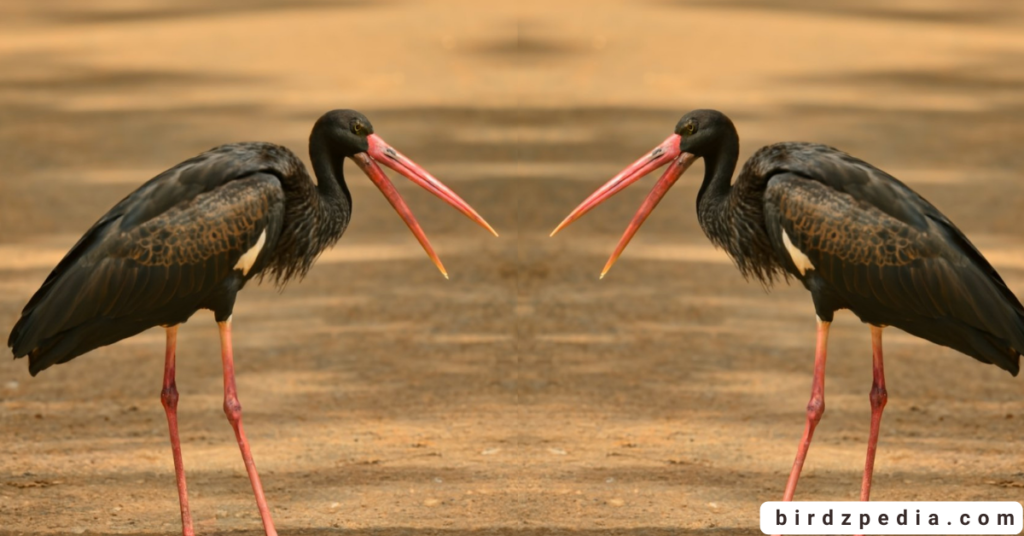
Breeding
| Aspect | Information |
|---|---|
| Breeding Season | Northern Hemisphere: April to May, with a peak in late April. Southern Africa: September to March. |
| Water Prey Exploitation | Rivers recede, and water prey availability increases from April to July in Zimbabwe, Botswana, and northern South Africa. |
| Courtship Rituals | Unique airborne rituals displayed by pairs, soaring above heavily forested breeding territory. |
| Nest Characteristics | Nest raised 4–25 meters high, primarily made of sticks and twigs in forest tree canopies. |
| Nest Location Preferences | Away from the main trunk, far from human disruptions, preferring deciduous trees, especially oaks. |
| Tree Species Preferences | Preferred trees include oak, European aspen, Scots pine (rejected Norway spruce), Calabrian pine, black pine, Turkey oak, and cork oak. |
| Nesting Locations | Mountainous areas, cliffs, rocks, caves, and beneath overhanging ledges in Spain, South Africa, Carpathian Mountains. |
| Nest Separation | One kilometer separates older single nests, with a diameter of 1-2 meters. |
| Nest Repair and Repurposing | Grass and mud are used, repurposing nests from various bird species. Lined with rags, paper, clay, leaves, moss, and animal hair. |
| Brood Characteristics | Consists of two to six large oval grey-white eggs. Asynchronous incubation over 32 to 38 days. Eggs laid every two days. |
| Hatching Period | Hatching typically by the end of May. Incubation shared by male and female. |
| Maturation and Flying | Young birds start flying around the end of July, taking 60 to 71 days to fully mature. |
| Post-Maturation Behavior | Juveniles join adults at feeding places. Additional two weeks of nighttime feeding and roosting in the nest. |
| Parental Care | At least one adult stays in the nest for the first two to three weeks after hatching. Parents feed young by spitting onto the nest floor. |
| Infanticide | Parents may commit infanticide when food is scarce, removing the weakest fledgling to enhance survival odds of others. |
| Reproductive Maturity and Survival | 20% of chicks reach reproductive maturity by age three. 10% and 5% survive for ten and twenty years, respectively. Captive storks reported to survive up to 36 years. |
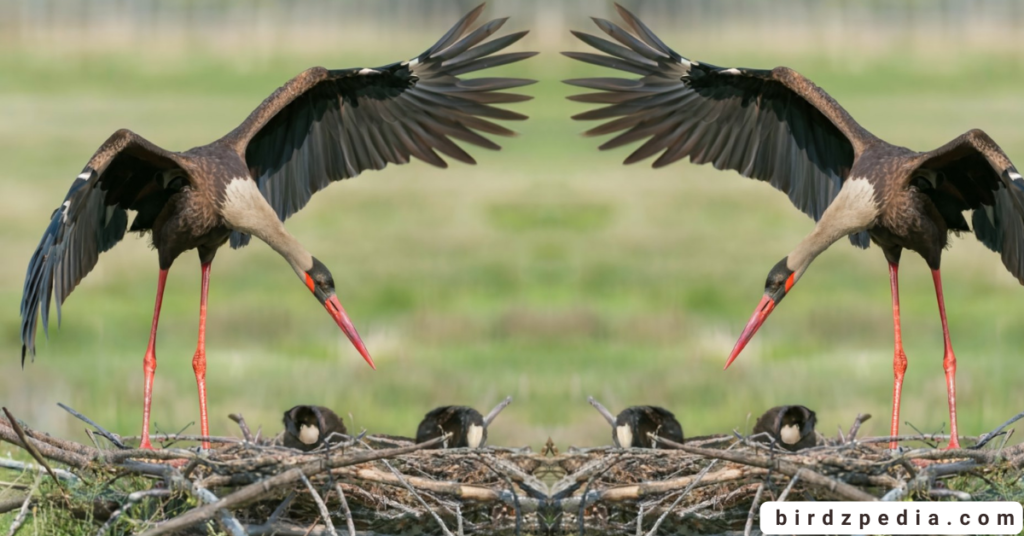
Diet
Fish such as small cyprinids, pikes, roaches, eels, budds, perches, burbots, sticklebacks, and muddy loaches (Misgurnus and Cobitis) are the main food source for them. Their varied food can include small reptiles, birds, crabs, earthworms, snails, mollusks, amphibians, and insects like water beetles and their larvae.
Foraging on dry land is fairly uncommon, although freshwater areas are their primary place to find food. When there is plenty of food available, this bird will patiently and deliberately wade in shallow water, either by itself or in small groups.
Interestingly, there have been reports of the Ciconia nigra searching by shading the water with its wings. It forages in mixed flocks in India frequently with other species such as the white stork, woolly-necked stork (Ciconia episcopus), demoiselle crane (Grus virgo), and bar-headed goose (Anser indicus).
They are also known to follow big mammals, such deer and livestock, probably so that it can feed on tiny animals and invertebrates that are disturbed by their presence.
Symbionts and parasites
More than a dozen different parasitic helminth species have been shown to be present of them; Dicheilonema ciconiae and Cathaemasia hians are the two most prevalent species. Though the adult Ciconia nigra helminth population is more diverse, the juvenile bird has a higher risk of parasitism.
Corynebacterium ciconiae is a species that was isolated and reported from the trachea of healthy Ciconia nigra. It is thought to be a part of the species’ natural flora.It has been discovered that the herpes virus is present in black storks.
Neophilopterus tricolor, Colpocephalum nigrae, and Ardeicola maculatus are among the birdlice found on the species. Their nests have been shown to harbor a variety of predatory mesostigmatid mites, mainly belonging to the genera Dendrolaelaps and Macrocheles.
Though it’s unclear exactly what these mites do for a living, they may feed on arthropod parasites.

Status and Conservation
Because of its large range (more than 20,000 km2) and a population decrease that does not fulfill the criteria for a vulnerable categorization, the black stork has been listed as least concern on the IUCN Red List since 1998.
Despite being extensively dispersed, the species’ overall population status is unknown, and it is not plentiful anywhere. Black storks in western Europe have been extinct as breeding birds in several areas, including the Netherlands and Scandinavia, since the 1950s due to a decline in population.
The Ciconia nigra, once a common winter visitor to the Mai Po Marshes, is becoming less common, suggesting a decline throughout China. A large area of Eastern Europe and Asia is experiencing significant environmental changes that are impacting the black stork’s habitat.
In order to improve the wintering circumstances for European breeding birds, a number of conservation initiatives have been put into place, such as Wetlands International’s Conservation Action Plan for African Black Storks.
The Convention on International Trade in Endangered Species of Wild Fauna and Flora (CITES) and the Agreement on the Conservation of African-Eurasian Migratory Waterbirds (AEWA) both have provisions outlining protective measures for this species.
Hunters pose a threat to their populations in many southern European and Asian nations, including Pakistan. This threat could lead to the extinction of breeding populations. The loss of the Ciconia nigra from the Ticino River basin in northern Italy was probably caused by hunting.
In the Parco Lombardo del Ticino, they were released in 2005 as part of a conservation initiative to aid in the repopulation of the species. They are classified by the IUCN as Moderately Depleted as of October 2021.
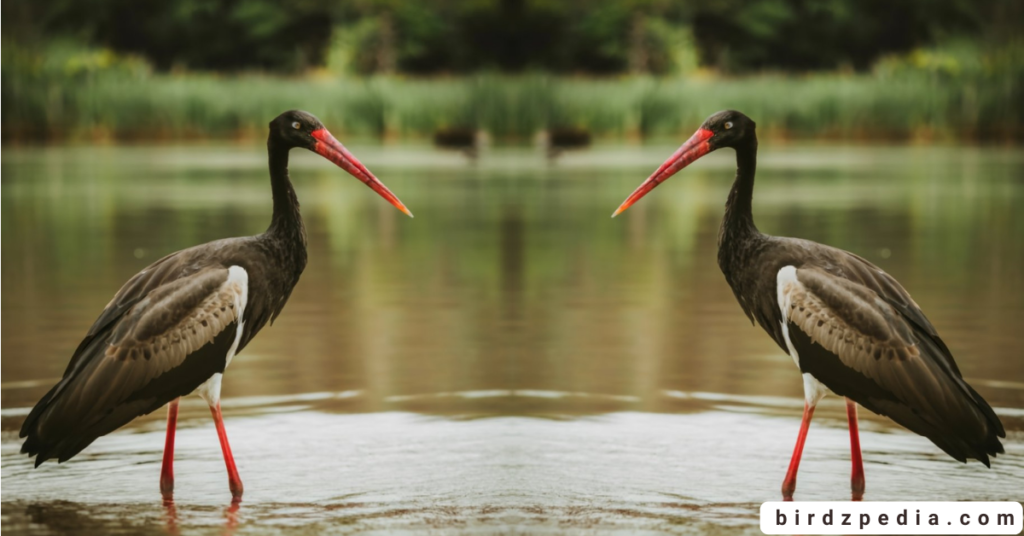
Common Names in Different Languages
| Language | Name |
|---|---|
| English | Black Stork |
| Catalan | Cigonya negra |
| Czech | čáp černý |
| Danish | Sort Stork |
| German | Schwarzstorch |
| Spanish | Cigüeña Negra |
| Spanish (Spain) | Cigüeña Negra |
| Finnish | mustahaikara |
| French | Cigogne noire |
| Croatian | Crna Roda |
| Hungarian | Fekete gólya |
| Icelandic | Kolstorkur |
| Italian | Cicogna nera |
| Japanese (romaji) | nabekou |
| Japanese | ナベコウ |
| Lithuanian | Juodasis gandras |
| Dutch | Zwarte Ooievaar |
| Norwegian Nynorsk | Svartstork |
| Norwegian | Svartstork |
| Polish | bocian czarny |
| Portuguese | Cegonha-preta |
| Portuguese (Portugal) | Cegonha-preta |
| Russian | Чёрный аист |
| Slovak | bocian čierny |
| Serbian | crna roda |
| Swedish | svart stork |
| Ukrainian | Лелека чорний |
| Chinese | 黑鹳 |
| Chinese (Traditional) | 黑鸛 |
FAQs
- What is the scientific name of the Black Stork?
- The scientific name is Ciconia nigra.
- Where is the natural habitat of their?
- Rivers, lakes, and marshes are just a few of the wetland areas that Ciconia nigra call home. They are found in portions of Africa, Asia, and Europe.
- What is the distinctive feature of the Black Stork?
- The black plumage and white belly of Ciconia nigra serve as distinguishing characteristics. They may have a white neck and chest, and they have a long, thin bill.
- What is the size of their?
- With a wingspan of 150 to 195 centimeters (59 to 77 inches), they are huge birds.
- What is their diet ?
- Their main sources of food are insects, fish, amphibians, and small animals. They are adept hunters that frequently search for food in shallow waters.
- Are they migratory birds?
- They migrate over great distances, particularly in the breeding season.
- Do Ciconia nigra nest in colonies?
- Usually, they nest alone or in small, dispersed colonies. Large stick nests are constructed by them in trees, rocks, and other high places.
- Are Ciconia nigra considered social birds?
- During the breeding season, Ciconia nigra can be seen in couples, despite not being as gregarious as some other species. They might be more alone after this time.
- What are the threats to them
- The loss of habitat, water body contamination, and disturbances during the breeding season are among the threats. Risks can also arise from human activity close to nesting locations.
- Are Ciconia nigra protected by conservation efforts?
- Although there are differences in conservation efforts, many areas take action to preserve wetland environments, which helps Black Stork numbers inadvertently. Certain locations also have legal protection.

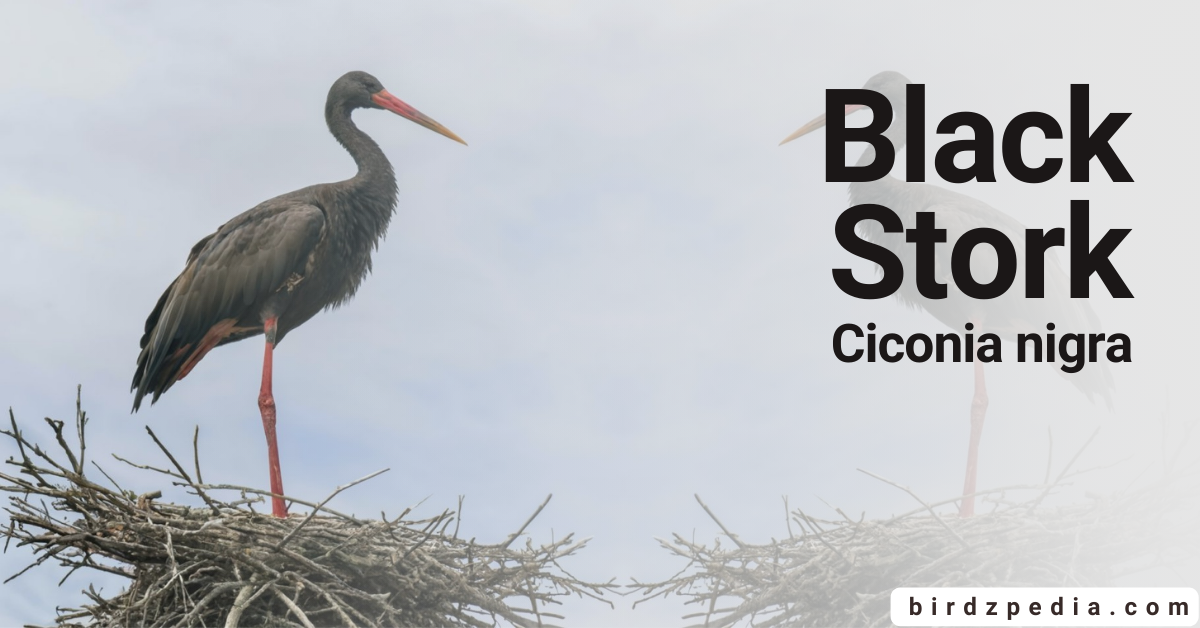
![Black Skimmer [Rynchops niger], Diet, Predators, and Characteristics](https://birdzpedia.com/wp-content/uploads/2023/12/Black-Skimmer-768x402.png)
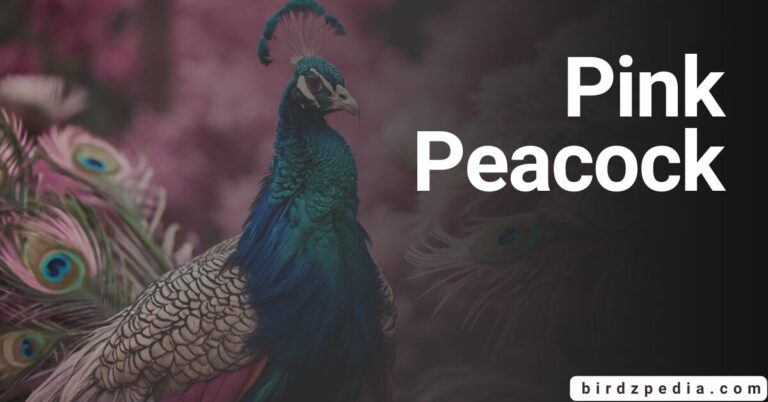
![Red-Naped Ibis [Pseudibis papillosa]: Facts, Sounds, Habitat](https://birdzpedia.com/wp-content/uploads/2023/12/Red-naped-ibis-768x402.png)
![Common raven[Corvus corax]: Journey into their World](https://birdzpedia.com/wp-content/uploads/2024/01/Common-raven-768x402.jpg)
![Pelagic cormorant: [Urile pelagicus] Odyssey Habitat, and Overview](https://birdzpedia.com/wp-content/uploads/2024/01/Channel-Billed-Toucan-1-768x402.png)
![Black Eagle[Ictinaetus malaiensis] Digging Deeper into their World](https://birdzpedia.com/wp-content/uploads/2023/12/birdzpedia.com-7-768x402.png)